Microsoft RM-109 GSM 900/1800/1900 Cellular Telephone w/ BT User Manual Nokia PL for FCC
Microsoft Mobile Oy GSM 900/1800/1900 Cellular Telephone w/ BT Nokia PL for FCC
Contents
- 1. Manual
- 2. manual
Manual
安全上のご注意

Copyright © 2005 Nokia. All rights reserved.
適合宣言 NOKIA CORPORATION は、その責任において、本製品「RM-109」が Council Directive 1999/5/EC の規
定に準拠していることをここに宣言します。適合宣言書につきましては、こちらをご参照ください。
http://www.nokia.com/phones/declaration_of_conformity/
Copyright © 2005 Nokia.All rights reserved.
本書を如何なる形式のものであっても、Nokia からの事前の書面による承諾を得ることなく、その内容の一部および全てを複製、譲渡、配布、保
管することを禁じます。
Nokia、Nokia Connecting People、Pop-Port は、Nokia Corporation の登録商標または商標です。本書に記載されている製品名、社名は、
各所有者の商標、または商標名です。
Nokia tune は Nokia Corporation の商標です。
本機には、Symbian Software Ltd (c) 1998-200(5) よりライセンス供与されたソフトウェアが含まれています。Symbian および Symbian
OS は、Symbian Ltd の商標です。
Java™よびすべての Java ベースの商標は、Sun Microsystems, Inc. の商標または登録商標です。
Bluetooth は、Bluetooth SIG, Inc. の登録商標です。
Stac ®, LZS ®, ©1996, Stac, Inc., ©1994-1996 Microsoft Corporation. 米国特許 No. 4701745、5016009、5126739、5146221
および 5414425 を取得しており、また、その他の特許を出願中です。
Hi/fn ®, LZS ®,©1988-98, Hi/fn. 米国特許 No 4701745、5016009、5126739、5146221、および 5414425 を取得しており、ま
た、その他の特許を出願中です。
本機ソフトウェアの一部の著作権 ©は ANT Ltd. が所有しています (1998 年 )。本機は米国特許 No 5818437 を取得しており、また、その他
の特許を出願中です。T9 テキスト入力ソフトウェアの著作権 ©は Tegic Communications, Inc.(www.intuwave.com) が所有しています
(1997-2005 年 )。
本製品は、下記に直接関連する場合以外、MPEG-4 ビジュアル標準に準拠したいかなる使用も禁止されています。(A) データまたは情報のうち
(1)事業に関連せずに消費者が作成しそこから無償で入手されたもので、かつ、(2)個人での利用のみを目的とするもの、並びに (B) その他、米
MPEG LA LLC(MPEG Licensing Administrator, Limited Liability Company)社より別途具体的に許諾された使用。
Nokia は製品の改良を継続的におこなっています。そのため、本書に記載された全ての製品の仕様は、事前の通知なしに変更または改良されるこ
とがあります。
Nokia は、状況のいかんを問わず、データまたは収益の喪失、またはいかなる特別損害、付随損害、派生損害、間接損害に対しても一切責任を負
いません。
本書は、現状有姿のまま提供されるものです。準拠法により要求される場合を除き、Nokia は、本書の正確性、信用性に関連するいかなる明示的
または黙示的保証も行いません。この保証には、商品性、および特定目的に対する適合性の黙示的な保証を含みますが、これに限定されません。
Nokia は、事前の通知なく本書を変更する権利または取り消す権利を有します。
使用できる製品は地域により異なります。お近くの Nokia 代理店にお問い合わせください。
輸出規制
本機には、米国および他の国の輸出関連法令の適用対象となる商品、技術、またはソフトウェアが含まれています。法令に違反する輸出は禁じら
れています。
第 1 版 9239626
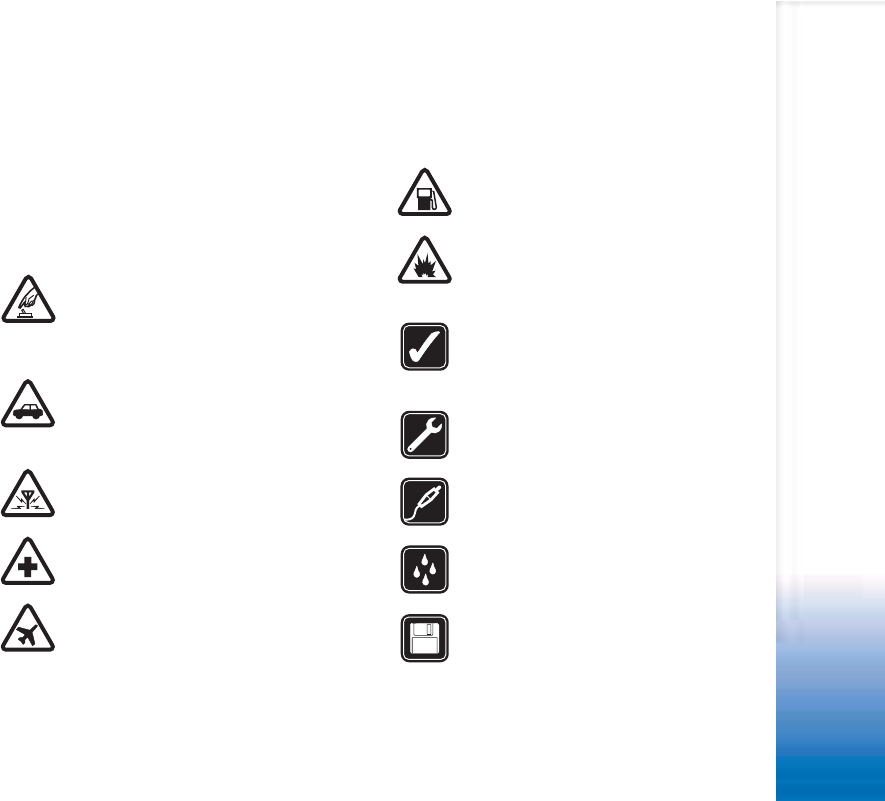
安全上のご注意
3
安全上のご注意
次のガイドラインをお読みください。ここに記載され
ている注意事項をお守りいただくことで、危険な状態
が生じる可能性や違法行為を未然に防ぐことができま
す。また、本書では更に詳しい説明も記載されていま
す。
安全を確認して電源をお入れください 携
帯電話の使用が禁止されている場合や、電
波干渉、または危険な状態を引き起こす可
能性がある場合は、電話機の電源を入れな
いでください。
交通安全を最優先に ご使用になる地域の
すべての法令に従ってください。運転中は
携帯電話を手に持たないで下さい。運転中
は安全第一を心がけてください。
電波干渉 携帯電話は電波干渉に敏感で、
電波干渉を受けると動作に影響が及ぶ場合
があります。
病院では電源をお切りください 規則に従
い、医療機器の近くでは電話機の電源をお
切りください。
航空機内では電源を切ってください 規則
に従い、無線機器の使用は、機内で何らか
の電波干渉を引き起こすことがあります。
給油時には電源をお切りください ガソリ
ンスタンドなど、燃料や化学薬品の近くで
は携帯電話を使用しないでください。
爆発現場付近では携帯電話を使用しないで
ください 規則に従い、爆発処理がおこな
われている現場では携帯電話を使用しない
でください。
正しくご使用ください 製品に付属の取扱
説明書に従い、電話機を通常の位置で使用
し、不必要にアンテナ部分に触れないでく
ださい。
正規サービス 資格のあるサービススタッ
フ以外は、装置の取り付けや修理をおこな
わないでください。
アクセサリと電池 指定のアクセサリや電
池を使用してください。また、本機に対応
していない機器を接続しないでください。
水をかけないでください 本機は防水仕様
ではありません。水気のあるところで使用
しないでください。
データのバックアップ 重要なデータは、
すべてバックアップ、またはメモを取るよ
うにしてください。
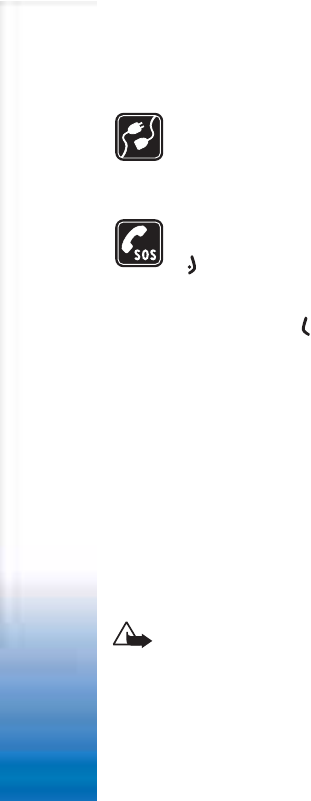
安全上のご注意
4
他の機器への接続 本機を他の機器へ接続
する場合、その製品に付属の取扱説明書
に記載された安全上の注意をお読みくだ
さい。また、本機に対応していない機器
を接続しないでください。
緊急通報 本機の電源が入っており、サー
ビスエリア内であることを確認します。
を必要なだけ押して通話中の電話を終
了する、または使用中のメニューを終了
し、待受画面に戻します。緊急通報の電
話番号を入力し、 を押します。電話がつ
ながったら現在地を知らせて、指示があ
るまで電話を切らないでください。
本機について
本機は EGSM900、GSM1800、GSM1900、
および WCDMA2000 ネットワーク上での利用が
認められています。これらのネットワークの詳細に
ついては、サービスプロバイダにお問い合わせくだ
さい。
本機を、すべての法律に従って正しくご使用くださ
い。また、他人のプライバシーや正当な権利を尊重
し、適切なご使用を心がけてください。
警告 : アラーム以外の本機のあらゆる機能を
使うためには、電源を入れる必要があります。
電波干渉や危険な事態を引き起こす可能性が
ある場合は、本機の電源を入れないで下さい。
ネットワークサービス
本機を利用するにあたって、携帯電話事業者のサービ
スが必要となります。本機の機能のほとんどがネット
ワーク側の機能に依存しています。これらのネット
ワークサービスは、すべてのネットワークで利用でき
るとは限りません。また、ネットワークサービスをご
利用になる前に、ご契約されている携帯電話事業者の
サービスに加入するなどの手続きが必要になる場合が
あります。ご契約されている携帯電話事業者から、
サービスをご利用する際の追加の指示や、課金につい
ての説明が必要になる場合があります。一部のネット
ワークでは、ネットワークサービスの利用に制限があ
る場合があります。ネットワークによっては、各言語
特有の文字やサービスをすべてサポートできない場合
があります。
ご契約されているサービスプロバイダが、本機の一部
の機能を停止、または無効にしている場合がありま
す。その場合は、それらの機能が本機のメニューに表
示されません。詳細については、サービスプロバイダ
にお問い合わせください。
本機は 3GPP GSM リリース 99 端末で、GPRS
サービスに対応しています。また、リリース 97
GPRS ネットワークに対応するよう設計されていま
すが、すべてのリリース 97 GPRS ネットワークに
おいて動作が保証されているわけではありません。詳
細についてはサービスプロバイダにお問い合わせくだ
さい。
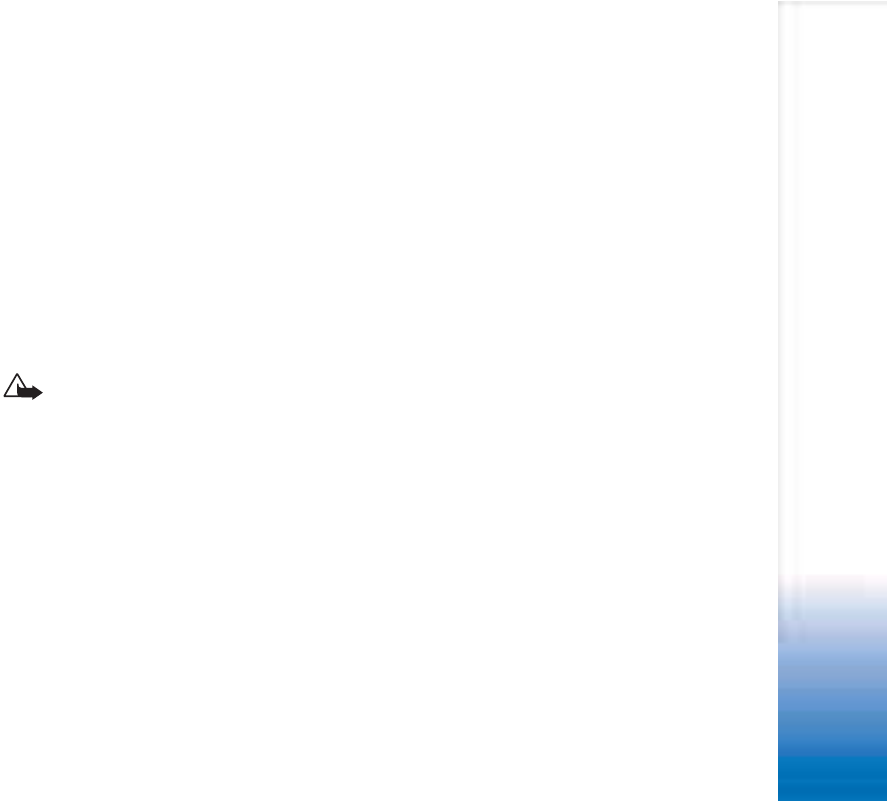
安全上のご注意
5
本機は、TCP/IP プロトコルを基盤とした WAP 2.0
プロトコル (HTTP と SSL) に対応しています。本機
のブラウザを経由したコンテンツダウンロードなどの
機能には、このような技術に対応したネットワークが
必要になります。
アクセサリ、電池、
充電器
充電器をご使用になる前に、充電器の型番を確認して
ください。本機は、ACP-12、LCH-12 充電器に対
応しています。
警告 : 本機を使用する際には、Nokia が認定し
た電池、充電器およびアクセサリのみを使用し
てください。それ以外の機器を使用すると、本
機に対する認定あるいは保証の対象外となるだ
けでなく、事故などが起こる場合があります。
認定アクセサリのご購入については、製品お買い上げ
店までお問い合わせください。アクセサリの電源コー
ドを外す際には、コードではなくプラグを持って抜い
てください。
本機やアクセサリには小さい部品がついています。お
子様の手の届く所に置かないでください。
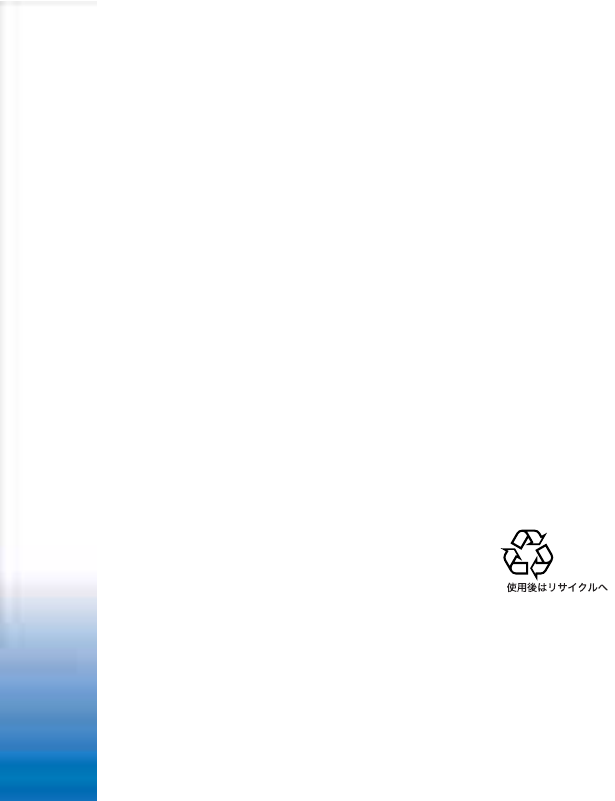
電池について
6
電池について
充電と放電
本機は、充電できる電池を電源として使用していま
す。新しい電池を使用する際には、完全充電と放電
のサイクルを 2、3 回繰り返すと、完全に充電でき
るようになります。電池は数百回充電と放電を繰り
返すことができますが、次第に消耗します。使用時
間 ( 通話時間と待受時間 ) が極端に通常より短くなっ
た場合は、新しい電池をお買い求めください。
Nokia 認定の電池以外は使用しないでください。ま
た、Nokia 認定の充電器以外を用いて電池の充電を
しないでください。
電池パックを外す前に、本機の電源が切ってあり、
充電器が接続されていないことを確認してください。
充電器を使用していないときは、コンセントから外
してください。充電したまま放置しないでください。
過充電は、電池の寿命を短くする場合があります。
完全に充電された電池は使用しなくても徐々に放電
します。極端な高温や低温の状態では、電池の充電
能力が低下します。
本来の目的以外にこの電池を使用しないでください。
損傷した充電器または電池を使用しないでください。
電池をショートさせないでください。金属物 ( コイ
ン、クリップ、またはペン ) が電池の金属部分のプ
ラス端子およびマイナス端子 ( 電池の金属部分 ) に直
接接続した場合、偶発的に電池がショートすることが
あります。このような事故は、ポケットまたは財布に
予備のバッテリーを携帯している場合などに起こる可
能性があります。端子をショートさせると、電池また
は接続物が損傷することがあります。
夏の閉め切った車中や寒い冬の日など、高温または低
温の場所に電池を放置しておくと、電池の容量と寿命
が短くなります。電池は常に 15 ℃∼ 25 ℃ (59°F
∼77
°F) の温度範囲で保管するようにしてください。
高温または低温状態の電池は、完全に充電されていて
も取り付けたときに一時的に本機が動作しない場合が
あります。0 ℃以下では、電池の性能が著しく制限さ
れます。
火の中へは絶対に電池を投げ込まないでください。電
池は、リサイクル処分など地域の条例に従って処理し
てください。可能な場合は、リサイクル処理してくだ
さい。一般廃棄物として廃棄しないでください。
Li-ion

お手入れとメンテナンスのお問い合わせ先
7
お手入れとメンテナンスのお問い合わせ先
本機の製造には、優れたデザインと技術が採用されて
います。お取り扱いには十分ご注意ください。保証の
対象範囲をお守りいただけるよう、次の記載事項をお
読みください。
・ 湿気のある場所に置かないでください。雨水、湿
気、および液体はミネラルを含み、電気回路を腐
食させます。本機が濡れた場合、電池を取り外し、
本機を完全に乾かしてから取り付けてください。
・ ほこりが多く、清潔でない場所で使用または保管
しないでください。電話機の可動部と電子部品が
損傷することがあります。
・ 高温の場所で保管しないでください。高温状態で
は、電子機器の寿命を短くするだけでなく、電池
が損傷したり、特定のプラスチック部品が変形し
たり、溶けたりする原因となります。
・ 低温の場所で保管しないでください。電話機を通
常の温度まで暖めると、本体の内部に結露が発生
し、電気回路基板に損傷をきたすことがあります。
・ 本書で指示された以外の方法で本機を分解しない
でください。
・ 本機を落としたり、たたいたり、振ったりしない
でください。手荒に取り扱うと、内部の回路基板
と優れた構造に損傷をきたすことがあります。
・ 本機のお手入れをする場合、刺激の強い化学薬品、
洗浄液、または強い洗剤を使用しないでください。
・ 本機を塗装しないでください。塗装すると装置の
可動部を詰まらせ、適切に動作しなくなることが
あります。
・ レンズ ( カメラレンズ、近接センサー、ライトセ
ンサーレンズ等 ) のお手入れには、柔らかくて清
潔な、乾いた布をお使いください。
・ 付属のアンテナ、または Nokia が認定した交換ア
ンテナのみを使用してください。無許可のアンテ
ナ、改造、付属品の取り付けは、電話機の損傷の
原因となり、無線装置についての規定に違反する
場合があります。
これらの注意事項は、電話機の本体、電池、充電器、
またはその他のアクセサリすべてに適用されます。適
切に動作しない機器がある場合は、製品お買い上げ店
までご相談ください。

安全についての追加情報
8
安全についての追加情報
操作環境
本機の利用について特別な規則がある場所では、それ
らの規則に従ってください。本機の使用が禁止されて
いる、または電波干渉や危険な事態を引き起こす可能
性がある場合は、本機の電源を入れないでください。
本機を通常の操作位置以外で、ご使用にならないでく
ださい。無線周波数暴露のガイドラインに適合するた
めに、Nokia が認定したアクセサリのみを使用して
ください。本機の電源が入っている状態で人体に身に
付ける場合は、Nokia 認定のキャリングケースに入
れてご使用ください。
医療機器
携帯電話を含む無線送信機の動作は、十分に保護され
ていない医療機器の機能を妨害する可能性がありま
す。医療機器が外部の RF 信号から十分に遮蔽されて
いるかを判断する際、またはご不明な点がありました
ら、医師または医療機器メーカーにご相談ください。
医療施設などで本機の電源を切るよう規則が掲示して
ある場合は、その指示に従ってください。病院または
医療施設では、外部の RF 信号に対して感度の高い電
気医療機器を使用している場合があります。
ペースメーカー ペースメーカー製造業者は、ペース
メーカーの誤作動を防ぐため、携帯電話をペースメー
カーから 15.3cm 以上離すことを勧めています。以
下の勧告は、「Wireless Technology Research」
が独自におこなった研究に基づいて推奨されるもので
す。ペースメーカーを装着されている方は、次の事項
を守ってください。
・ 本機の電源が入っているときは、常に本機をペー
スメーカーから 15.3cm 以上離してください。
・ 胸ポケットに本機を入れて持ち運ぶのはおやめく
ださい。
・ ペースメーカーの誤作動を最小限にするため、
ペースメーカーを装着している側の反対の耳で本
機をご使用ください。
ペースメーカーの誤作動が少しでも感じられた場合
は、すぐに本機の電源を切ってください。
補聴器 デジタル無線機が一部の補聴器の動作を干渉
する場合があります。万が一、そのような干渉があっ
た場合は、ご契約されているサービスプロバイダまで
ご相談ください。
自動車
RF 信号は、適切に取り付けられていない、または十
分に遮蔽されていない自動車の電子装置 ( 電子燃料噴
射システム、電子アンチロックブレーキ装置、電子速
度制御装置、およびエアバック装置など ) に影響を与
える場合があります。詳しい情報につきましては、自
動車および追加装備した装置のメーカー、または代理
店にご確認ください。
資格を有するスタッフ以外は、本機の修理、または自
動車への本機の取り付けをしないでください。誤った
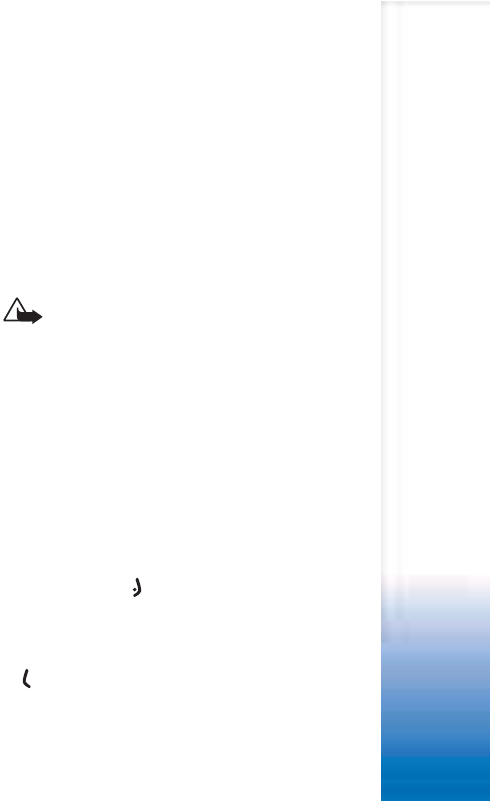
安全についての追加情報
9
取り付けや修理は危険を伴うことがあるだけでなく、
本機に適用されるすべての保証が無効になる場合があ
ります。車内の無線機は、適切に取り付けられ、正常
に動作していることを定期的に確認してください。可
燃性の液体、ガス、または爆発性物質を、本機、その
部品、またはアクセサリと一緒に車内に保管、または
持ち運ばないでください。エアバックを装備した自動
車では、エアバックが強い力で膨らみます。エアバッ
クの上の部分、またはエアバックが膨らむ範囲に、固
定無線機と移動無線機の両方を含めて、物を置かない
でください。車内の無線機が適切に取り付けられてい
ない場合、エアバックが膨らんだときに重傷を負うこ
とがあります。
飛行中に本機を使用することは禁止されています。航
空機に搭乗する前に本機の電源を切ってください。航
空機内で携帯電話を使用すると、航空機の操作に危険
をもたらし、無線通信が混信する原因にもなります。
また機内での携帯電話の使用は違法となる場合もあり
ます。
爆発の危険がある場所
爆発の危険がある場所では、本機の電源を切り、すべ
ての標識や指示に従ってください。爆発の危険がある
場所とは、通常自動車のエンジンを停止するよう指示
されている場所を含みます。そのような場所で発生す
る火花は、爆発または火災の原因となり、怪我や死に
つながる恐れがあります。ガソリンスタンドのガソリ
ンポンプの近くといった給油地点では、本機の電源を
切ってください。給油箇所、燃料貯蔵、燃料販売場
所、化学工場、または爆破作業がおこなわれている現
場での無線機の使用に関する規制に従ってください。
爆発の危険がある場所は、たいていの場合は明確に表
示されていますが、常にそうであるとは限りません。
そのような場所としては、船のデッキの下、化学物質
の搬送または保管施設、液化石油ガス ( プロパンまた
はブタン等 ) を使用する自動車、大気中に結晶粒、ほ
こり、または金属粉末といった化学物質または微粒子
が含まれる場所があります。
緊急通報
重要 : 他の携帯電話と同じように、本機は無線
信号、無線ネットワーク、有線ネットワークおよびお
客様によってプログラムされた機能も使用しているた
め、. すべての条件で接続を保証できるものではあり
ません。従って、救急車を呼ぶ場合といった非常に重
要な連絡には、無線機だけに頼らないようにしてくだ
さい。
緊急電話番号に電話をかけるには
1本機の電源が入っていない場合は、電源を入れま
す。電波が十分に届いていることを確認してくださ
い。
ネットワークによっては、有効な SIM カードを電
話機に挿入するよう要求される場合があります。
2必要な回数だけ を押して画面をクリアし、電話
がかけられる状態にします。
3現在いる地域の緊急電話番号を入力します。地域
によって緊急電話番号は異なります。
4を押して電話をかけます。
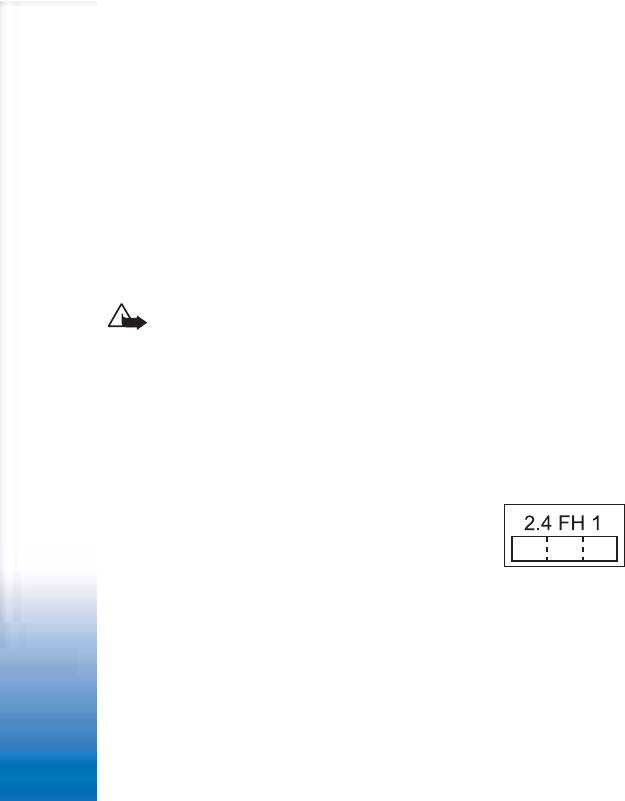
安全についての追加情報
10
使用中の機能によっては、緊急電話番号に電話をかけ
る前に機能を終了する必要があります。詳細は本書を
参照の上、ご契約されている携帯電話事業者にお問い
合わせください。
緊急電話番号に電話をかける場合、必要な情報をでき
る限り正確に伝えることを心がけてください。事故現
場では、お客様の無線機が唯一の通信手段となる場合
があります。指示があるまでは電話を切らないでくだ
さい。
警告:オフラインモードでは、特定の緊急電話
番号以外に電話をかけたり、ネットワーク接続
が必要な機能を使用したりできません。
Bluetooth の周波数について この機器の使用周波
数帯では、電子レンジ等の産業・科学・医療用機器の
ほか、工場の製造ライン等で使用される免許を要する
移動体識別用構内無線局、免許を要しない特定小電力
無線局、アマチュア無線局等(以下「他の無線局」と
略します)が運用されています。
この機器を使用する前に、近くで「他の無線局」が運
用されていないことを確認してください。
万一、この機器から「他の無線局」との間に電波干渉
が発生した場合には、速やかに使用場所を変更する
か、電波の発射を停止して電波干渉を避けてくださ
い。
日本国内でのご使用に関して不明な点や何かお困りの
際は、次の連絡先へお問い合わせください。
連絡先:ノキアコンタクトセンター「ハローノキア」
0570-0-66542
http://www.nokia.co.jp
この機器の使用周波数帯は
2.4GHz 帯です。
変調方式として FH-SS 変調方
式を採用しています。想定与干
渉距離は 10m 以下です。
For Your Safety

Copyright © 2005 Nokia. All rights reserved.
DECLARATION OF CONFORMITY We, NOKIA
CORPORATION declare under our sole responsibility
that the product RM-109 is in conformity with the
provisions of the following Council Directive: 1999/5/
EC. A copy of the Declaration of Conformity can be found at http://
www.nokia.com/phones/declaration_of_conformity/
Copyright © 2005 Nokia. All rights reserved.
Reproduction, transfer, distribution or storage of part or all of the contents in this
document in any form without the prior written permission of Nokia is prohibited.
Nokia, Nokia Connecting People, and Pop-Port are trademarks or registered
trademarks of Nokia Corporation. Other product and company names mentioned
herein may be trademarks or tradenames of their respective owners.
Nokia tune is a sound mark of Nokia Corporation.
This product includes software licensed from Symbian Software Ltd (c) 1998-
200(5). Symbian and Symbian OS are trademarks of Symbian Ltd.
Java™ and all Java-based marks are trademarks or registered trademarks of Sun
Microsystems, Inc.
Bluetooth is a registered trademark of Bluetooth SIG, Inc.
Stac ®, LZS ®, ©1996, Stac, Inc., ©1994-1996 Microsoft Corporation. Includes one
or more U.S. Patents: No. 4701745, 5016009, 5126739, 5146221, and 5414425.
Other patents pending.
Hi/fn ®, LZS ®,©1988-98, Hi/fn. Includes one or more U.S. Patents: No. 4701745,
5016009, 5126739, 5146221, and 5414425. Other patents pending.
Part of the software in this product is © Copyright ANT Ltd. 1998. All rights reserved.
US Patent No 5818437 and other pending patents. T9 text input software Copyright
(C) 1997-2005. Tegic Communications, Inc. All rights reserved.
USE OF THIS PRODUCT IN ANY MANNER THAT COMPLIES WITH THE MPEG-4
VISUAL STANDARD IS PROHIBITED, EXCEPT FOR USE DIRECTLY RELATED TO (A)
DATA OR INFORMATION (i) GENERATED BY AND OBTAINED WITHOUT CHARGE
FROM A CONSUMER NOT THEREBY ENGAGED IN A BUSINESS ENTERPRISE, AND (ii)
FOR PERSONAL USE ONLY; AND (B) OTHER USES SPECIFICALLY AND SEPARATELY
LICENSED BY MPEG LA, L.L.C.
Nokia operates a policy of continuous development. Nokia reserves the right to
make changes and improvements to any of the products described in this document
without prior notice.
Under no circumstances shall Nokia be responsible for any loss of data or income
or any special, incidental, consequential or indirect damages howsoever caused.
The contents of this document are provided ‘as is’. Except as required by applicable
law, no warranties of any kind, either express or implied, including, but not limited
to, the implied warranties of merchantability and fitness for a particular purpose,
are made in relation to the accuracy, reliability or contents of this document. Nokia
reserves the right to revise this document or withdraw it at any time without prior
notice
The availability of particular products may vary by region. Please check with the
Nokia dealer nearest to you.
Export Controls
This device may contain commodities, technology or software subject to export
laws and regulations from the US and other countries. Diversion contrary to law is
prohibited.
FCC INDUSTRY CANADA NOTICE
Your device may cause TV or radio interference (for example, when using a
telephone in close proximity to receiving equipment). The FCC or Industry Canada
can require you to stop using your telephone if such interference cannot be
eliminated. If you require assistance, contact your local service facility. This device
complies with part 15 of the FCC rules. Operation is subject to the condition that
this device does not cause harmful interference.
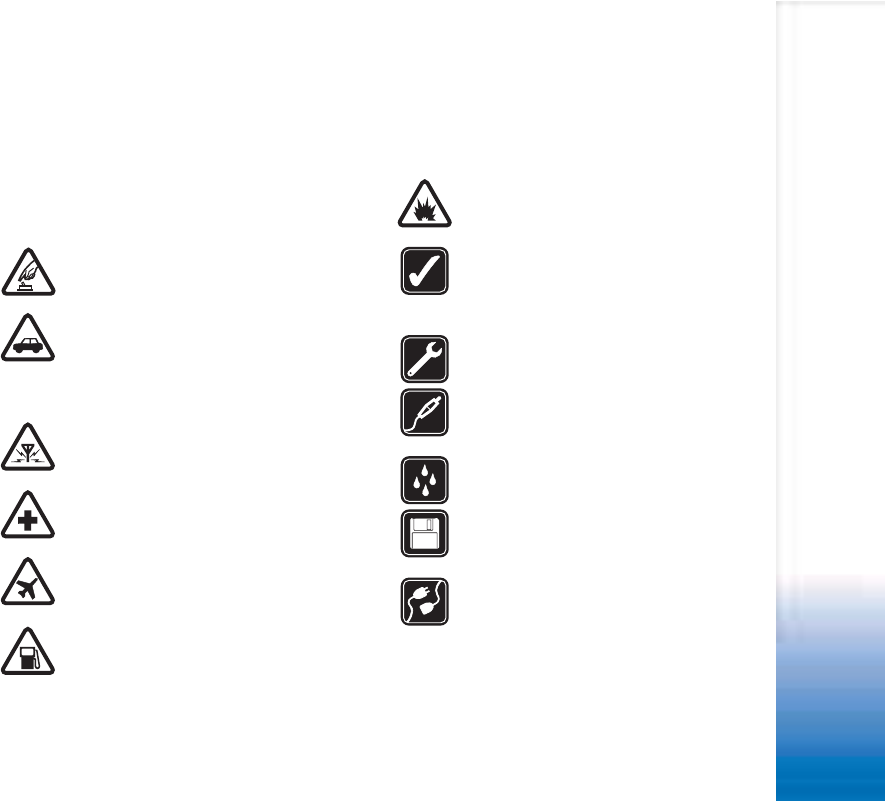
3
FOR YOUR SAFETY
Read these simple guidelines. Not following them may be
dangerous or illegal. Read the complete user guide for
further information.
SWITCH ON SAFELY Do not switch the phone
on when wireless phone use is prohibited or
when it may cause interference or danger.
ROAD SAFETY COMES FIRST Obey all local
laws. Always keep your hands free to operate
the vehicle while driving. Your first
consideration while driving should be road
safety.
INTERFERENCE All wireless phones may be
susceptible to interference, which could affect
performance.
SWITCH OFF IN HOSPITALS Follow any
restrictions. Switch the phone off near medical
equipment.
SWITCH OFF IN AIRCRAFT Follow any
restrictions. Wireless phones can cause
interference in aircraft.
SWITCH OFF WHEN REFUELLING Don't use
the phone at a refuelling point. Don't use near
fuel or chemicals.
SWITCH OFF NEAR BLASTING Follow any
restrictions. Don't use the phone where
blasting is in progress.
USE SENSIBLY Use only in the normal
position as explained in the product
documentation. Don't touch the antenna
unnecessarily.
QUALIFIED SERVICE Only qualified personnel
may install or repair this product.
ENHANCEMENTS AND BATTERIES Use only
approved enhancements and batteries. Do not
connect incompatible products.
WATER-RESISTANCE Your phone is not
water-resistant. Keep it dry.
BACK-UP COPIES Remember to make back-
up copies or keep a written record of all
important information.
CONNECTING TO OTHER PHONES When
connecting to any other phone, read its user
guide for detailed safety instructions. Do not
connect incompatible products.
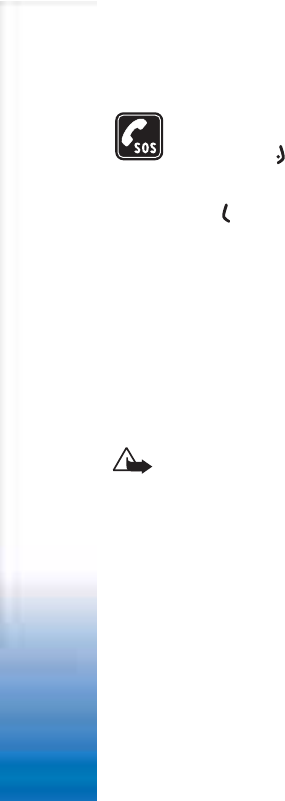
4
EMERGENCY CALLS Ensure the phone
function of the phone is switched on and in
service. Press as many times as needed to
clear the display and return to the start
screen. Enter the emergency number, then
press . Give your location. Do not end the
call until given permission to do so.
ABOUT YOUR DEVICE
The wireless device described in this guide is approved for
use on the EGSM 900/1800/1900, and WCDMA 2000
network. Contact your service provider for more
information about networks.
When using the features in this device, obey all laws and
respect privacy and legitimate rights of others.
Warning: To use any features in this device, other
than the alarm clock, the phone must be switched
on. Do not switch the device on when wireless
phone use may cause interference or danger.
Network Services
To use the phone you must have service from a wireless
service provider. Many of the features in this device
depend on features in the wireless network to function.
These Network Services may not be available on all
networks or you may have to make specific arrangements
with your service provider before you can utilize Network
Services. Your service provider may need to give you
additional instructions for their use and explain what
charges will apply. Some networks may have limitations
that affect how you can use Network Services. For
instance, some networks may not support all language-
dependent characters and services.
Your service provider may have requested that certain
features be disabled or not activated in your device. If so,
they will not appear on your device menu. Contact your
service provider for more information.
This wireless device is a 3GPP GSM Release 99 terminal
supporting GPRS service, and is designed to support also
Release 97 GPRS networks. However, there may be some
compatibility issues when used in some Release 97 GPRS
networks. For more information, contact your service
provider.
This device supports WAP 2.0 protocols (HTTP and SSL) that
run on TCP/IP protocols. Some features of this device, such
as MMS, browsing, e-mail and content downloading via
browser or over MMS, require network support for these
technologies.
Enhancements, batteries, and
chargers
Check the model number of any charger before use with
this phone. This phone is intended for use when supplied
with power from ACP-12 and LCH-12.
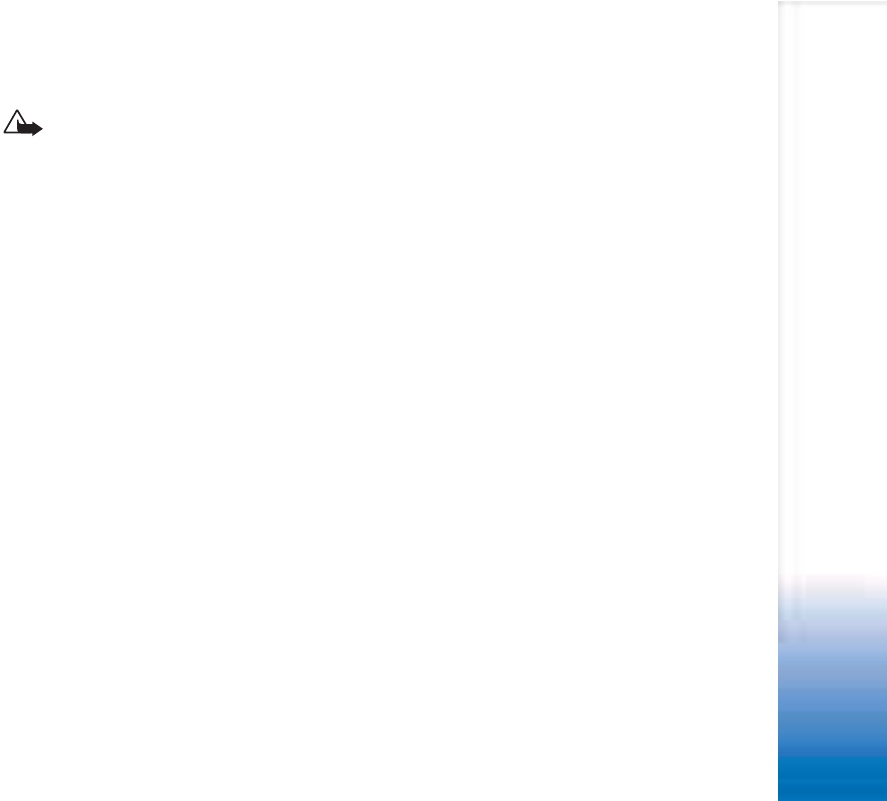
5
Warning: Use only batteries, chargers, and
enhancements approved by Nokia for use with this
particular model. The use of any other types may
invalidate any approval or warranty, and may be
dangerous.
For availability of approved enhancements, please check
with your dealer. When you disconnect the power cord of
any enhancement, grasp and pull the plug, not the cord.
Your phone and its enhancements may contain small
parts. Keep them out of reach of small children.
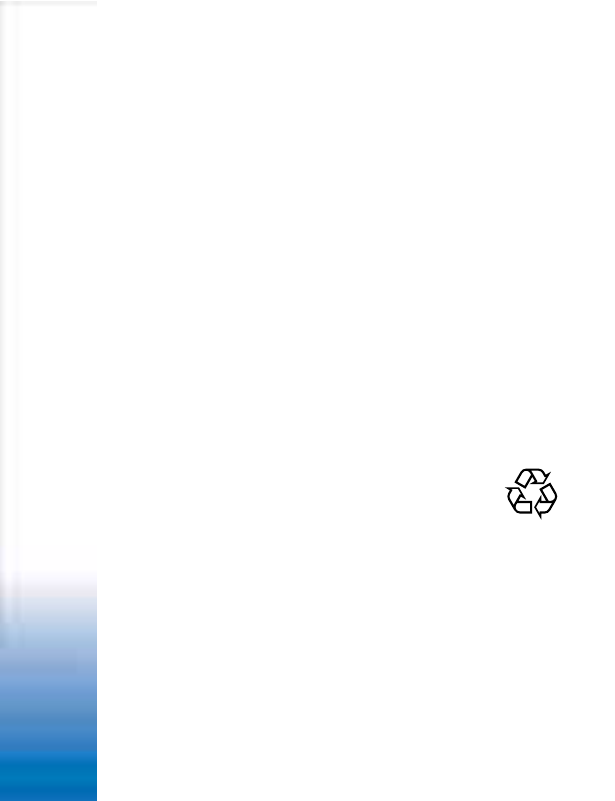
Battery information
6
Battery information
Charging and Discharging
Your device is powered by a rechargeable battery. The full
performance of a new battery is achieved only after two or
three complete charge and discharge cycles. The battery can
be charged and discharged hundreds of times but it will
eventually wear out. When the talk and standby times are
noticeably shorter than normal, buy a new battery. Use only
Nokia approved batteries, and recharge your battery only with
Nokia approved chargers designated for this device.
Always switch the device off and disconnect the charger
before removing the battery.
Unplug the charger from the electrical plug and the device
when not in use. Do not leave the battery connected to a
charger. Overcharging may shorten its lifetime. If left unused,
a fully charged battery will lose its charge over time.
Temperature extremes can affect the ability of your battery to
charge.
Use the battery only for its intended purpose. Never use any
charger or battery that is damaged.
Do not short-circuit the battery. Accidental short-circuiting
can occur when a metallic object such as a coin, clip, or pen
causes direct connection of the positive (+) and negative (-)
terminals of the battery. (These look like metal strips on the
battery.) This might happen, for example, when you carry a
spare battery in your pocket or purse. Short-circuiting the
terminals may damage the battery or the connecting object.
Leaving the battery in hot or cold places, such as in a closed
car in summer or winter conditions, will reduce the capacity
and lifetime of the battery. Always try to keep the battery
between 15°C and 25°C (59°F and 77°F). A device with a hot
or cold battery may not work temporarily, even when the
battery is fully charged. Battery performance is particularly
limited in temperatures well below freezing.
Do not dispose of batteries in a fire! Dispose of batteries
according to local regulations. Please recycle when possible.
Do not dispose as household waste.
Li-ion

CARE AND MAINTENANCE
7
CARE AND MAINTENANCE
Your device is a product of superior design and craftsmanship
and should be treated with care. The suggestions below will
help you protect your warranty coverage.
• Keep the device dry. Precipitation, humidity and all types
of liquids or moisture can contain minerals that will
corrode electronic circuits. If your device does get wet,
remove the battery and allow the device to dry completely
before replacing it.
• Do not use or store the device in dusty, dirty areas. Its
moving parts and electronic components can be damaged.
• Do not store the device in hot areas. High temperatures
can shorten the life of electronic devices, damage
batteries, and warp or melt certain plastics.
• Do not store the device in cold areas. When the device
returns to its normal temperature, moisture can form
inside the device and damage electronic circuit boards.
• Do not attempt to open the device other than as instructed
in this guide.
• Do not drop, knock, or shake the device. Rough handling
can break internal circuit boards and fine mechanics.
• Do not use harsh chemicals, cleaning solvents, or strong
detergents to clean the device.
• Do not paint the device. Paint can clog the moving parts
and prevent proper operation.
• Use a soft, clean, dry cloth to clean any lenses (such as
camera, proximity sensor, and light sensor lenses).
• Use only the supplied or an approved replacement
antenna. Unauthorised antennas, modifications, or
attachments could damage the device and may violate
regulations governing radio devices.
All of the above suggestions apply equally to your device,
battery, charger, or any enhancement. If any device is not
working properly, take it to the nearest authorized service
facility for service.

ADDITIONAL SAFETY INFORMATION
8
ADDITIONAL SAFETY INFORMATION
Operating environment
Remember to follow any special regulations in force in any
area and always switch off your device when its use is
prohibited or when it may cause interference or danger. Use
the device only in its normal operating positions. This device
meets RF exposure guidelines when used either in the normal
use position against the ear or when positioned at least 5/8
inch (1.5 cm) away from the body. When a carry case, belt
clip, or holder is used for body-worn operation, it should not
contain metal and should position the device at least 5/8 inch
(1.5 cm) away from your body. In order to transmit data files
or messages, this device requires a quality connection to the
network. In some cases, transmission of data files or messages
may be delayed until such a connection is available. Ensure
the above separation distance instructions are followed until
the transmission is completed.
Medical devices
Operation of any radio transmitting equipment, including
wireless phones, may interfere with the functionality of
inadequately protected medical devices. Consult a physician
or the manufacturer of the medical device to determine if
they are adequately shielded from external RF energy or if you
have any questions. Switch off your device in health care
facilities when any regulations posted in these areas instruct
you to do so. Hospitals or health care facilities may be using
equipment that could be sensitive to external RF energy.
Pacemakers Pacemaker manufacturers recommend that a
minimum separation of 6 in. (15.3 cm) be maintained
between a wireless phone and a pacemaker to avoid potential
interference with the pacemaker. These recommendations are
consistent with the independent research by and
recommendations of Wireless Technology Research. Persons
with pacemakers should:
• always keep the device more than 6 in. (15.3 cm) from their
pacemaker when the device is switched on;
• not carry the device in a breast pocket; and
• hold the device to the ear opposite the pacemaker to
minimise the potential for interference.
If you have any reason to suspect that interference is taking
place, switch off your device immediately.
Hearing aids Some digital wireless devices may interfere
with some hearing aids. If interference occurs, consult your
service provider.
Vehicles
RF signals may affect improperly installed or inadequately
shielded electronic systems in motor vehicles such as
electronic fuel injection systems, electronic antiskid (antilock)
braking systems, electronic speed control systems, air bag
systems. For more information, check with the manufacturer
or its representative of your vehicle or any equipment that has
been added.
Only qualified personnel should service the device, or install
the device in a vehicle. Faulty installation or service may be
dangerous and may invalidate any warranty that may apply to
the device. Check regularly that all wireless device equipment
in your vehicle is mounted and operating properly. Do not store
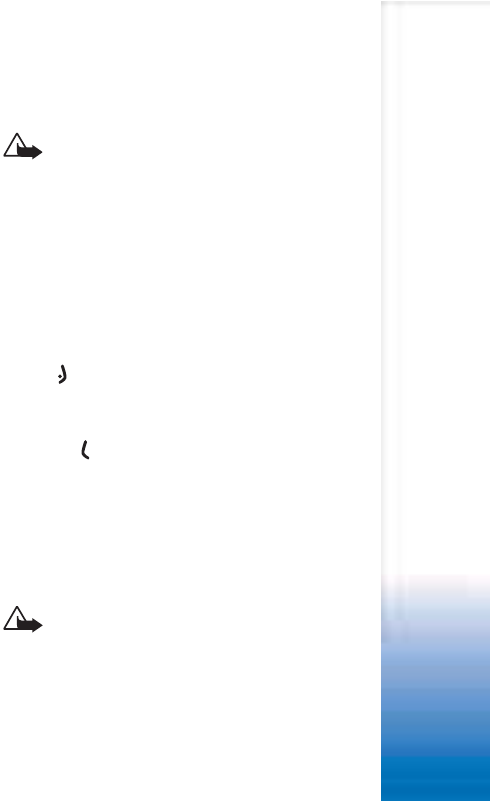
ADDITIONAL SAFETY INFORMATION
9
or carry flammable liquids, gases, or explosive materials in the
same compartment as the device, its parts, or enhancements.
For vehicles equipped with an air bag, remember that air bags
inflate with great force. Do not place objects, including
installed or portable wireless equipment in the area over the
air bag or in the air bag deployment area. If in-vehicle wireless
equipment is improperly installed and the air bag inflates,
serious injury could result.
Using your device while flying in aircraft is prohibited. Switch
off your device before boarding an aircraft. The use of wireless
teledevices in an aircraft may be dangerous to the operation
of the aircraft, disrupt the wireless telephone network, and
may be illegal.
Potentially explosive environments
Switch off your device when in any area with a potentially
explosive atmosphere and obey all signs and instructions.
Potentially explosive atmospheres include areas where you
would normally be advised to turn off your vehicle engine.
Sparks in such areas could cause an explosion or fire resulting
in bodily injury or even death. Switch off the device at
refuelling points such as near gas pumps at service stations.
Observe restrictions on the use of radio equipment in fuel
depots, storage, and distribution areas, chemical plants or
where blasting operations are in progress. Areas with a
potentially explosive atmosphere are often but not always
clearly marked. They include below deck on boats, chemical
transfer or storage facilities, vehicles using liquefied
petroleum gas (such as propane or butane), and areas where
the air contains chemicals or particles such as grain, dust or
metal powders.
Emergency calls
Important: Wireless phones, including this device,
operate using radio signals, wireless networks, landline
networks, and user-programmed functions. Because of
this, connections in all conditions cannot be guaranteed.
You should never rely solely on any wireless device for
essential communications like medical emergencies.
To make an emergency call:
1 If the device is not on, switch it on. Check for adequate
signal strength.
Some networks may require that a valid SIM or USIM card
is properly inserted in the device.
2Press as many times as needed to clear the display and
ready the device for calls.
3Enter the official emergency number for your present
location. Emergency numbers vary by location.
4Press the key.
If certain features are in use, you may first need to turn those
features off before you can make an emergency call. Consult
this guide or your service provider for more information.
When making an emergency call, give all the necessary
information as accurately as possible. Your wireless device
may be the only means of communication at the scene of an
accident. Do not end the call until given permission to do so.
WARNING! In Offline profile you cannot make
calls, except calls to certain emergency numbers, or
use features that require network coverage.

ADDITIONAL SAFETY INFORMATION
10
Certification information (SAR)
THIS DEVICE MEETS GUIDELINES FOR EXPOSURE TO RADIO
WAVES.
Your mobile device is a radio transmitter and receiver. It is
designed and manufactured not to exceed the limits for
exposure to radio frequency (RF) energy recommended by
international guidelines (ICNIRP). These limits establish
permitted levels of RF energy for the general population. The
guidelines are based on standards that were developed by
independent scientific organizations through periodic and
thorough evaluation of scientific studies. The standards and
guidelines include a substantial safety margin designed to
assure the safety of the public, regardless of age and health
and to account for any variations in measurements.
The exposure guidelines for mobile devices employ a unit of
measurement known as the Specific Absorption Rate or SAR.
The SAR limit stated in the international guidelines is 2.0
watts/kilogram (W/kg) averaged over ten grams of tissue.
Tests for SAR are conducted using standard operating
positions with the device transmitting at its highest certified
power level in all tested frequency bands. The actual SAR level
of an operating device can be well below the maximum value
because the device is designed to use only the power required
to reach the network. That amount changes depending on a
number of factors such as how close you are to a network
base station. The highest SAR value when tested according to
international testing procedures for use at the ear is 0.63W/
kg.
SAR values may vary depending on national reporting and
testing requirements and the network band. Use of device
accessories and enhancements may result in different SAR
values. Additional SAR information may be provided under
product information at www.nokia.com.
USA and Canada: The SAR limit of USA (FCC) and Canada (IC)
is 1.6 W/kg averaged over one gram of tissue. This device
model has also been tested against this SAR limit. The highest
SAR value reported under this standard during product
certification for use at the ear is 0.57W/kg and when properly
worn on the body is 0.57W/kg. Information about this device
can be found on the FCC's website at http://www.fcc.gov/oet/
fccid by searching the equipment authorization system using
FCC ID: QVVRM-109.
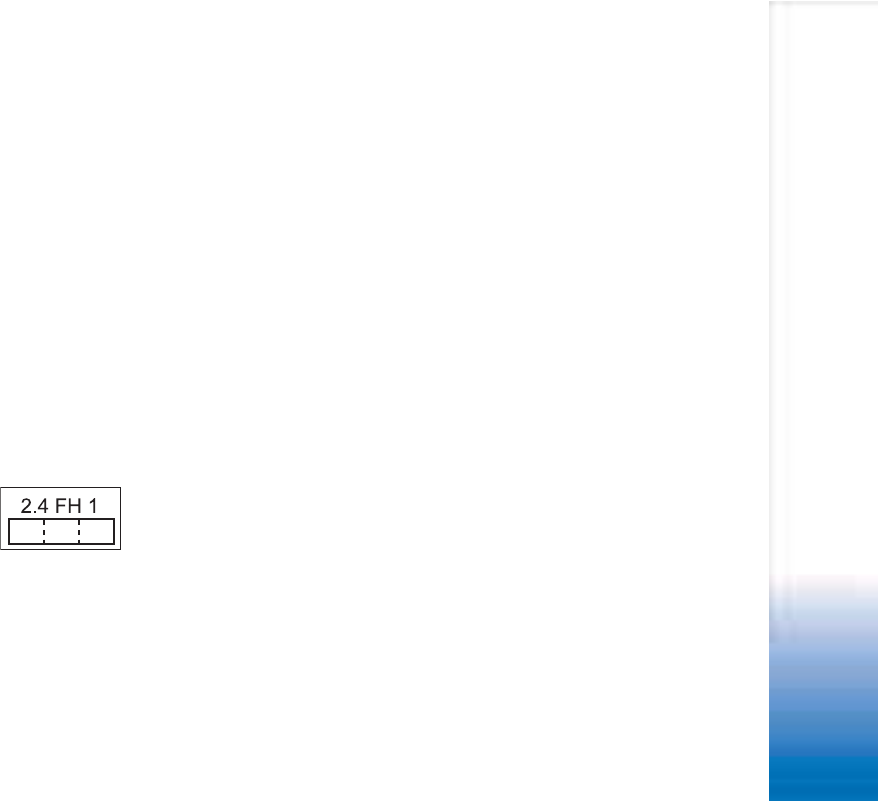
ADDITIONAL SAFETY INFORMATION
11
Bluetooth frequency band
Industrial, scientific and medical devices such as microwave
ovens, licensed premises radio stations for moving object
identification system in factory production lines, specified low
power radio stations which do not require licenses, and
amateur radio stations (hereafter referred to as "other radio
stations") also use the frequency bandwidth used by this
product.
Please make sure that there are no "other radio stations"
nearby before using this product.
If radio wave interferences between this product and "other
radio stations" occur, please change your location or stop
transmitting radio waves to avoid radio wave interferences.
If you have any questions or encounter any problems in using
this product in Japan, please contact the number below.
Contact: Hello NOKIA
0570-0-66542
http://www.nokia.co.jp
This product uses 2.4GHz and utilizes
the FH-SS modulation system. The
estimated interference distance is
10m or less.